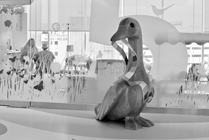Search Results
Viewing: 111-120 of 11716 | All

Condition
Turner Syndrome
Turner Syndrome is a rare genetic disorder that affects females. It is caused by a partial or complete loss of an X chromosome.

Condition
Bipolar Disorder
Bipolar disorder, formerly known as manic-depression, is a chronic mental illness that causes extreme mood swings from high to low.

Condition
Enuresis (Bedwetting)
Enuresis is the medical term for wetting the bed. It means a child urinates without meaning to. Treatment usually means helping a child to form habits that will allow him to control his need to urinate.

Condition
Allergy to Dust Mites
This Helping Hand™ covers allergy to dust mites. When a person who is sensitive to the dust mite breathes in these particles, they can cause sneezing, coughing, runny nose, congestion and itchy, watery eyes.

Condition
Prepubertal Vaginal Bleeding
There are several different reasons why a pediatric patient may experience vaginal bleeding. It is important to notify your health care provider if you notice your child is having vaginal bleeding.

Condition
Vaginal Atresia
Vaginal atresia is a condition a child is born with. The vagina might not be formed completely, meaning it is closed or absent. Treatment includes dilators or surgery.

Condition
Lateral Collateral Ligament Sprain
The lateral collateral ligament (LCL) is one of the 4 major ligaments of the knee. An injury to the LCL alone is not common and often occurs with knee injuries.

Condition
Congenital Hypothyroidism
This Helping Hand™ is about congenital hypothyroidism, which is when a baby is born without enough thyroid hormone. Learn more about symptoms and treatment for congenital hypothyroidism here.

Condition
Bicuspid Aortic Valve
Bicuspid aortic valve disease (BAV) is an irregularity in the heart where there are only two leaflets on a valve, instead of the normal three.

Condition
D-Transposition of the Great Vessels
D-Transposition of the great vessels (d-TGA) is a congenital heart defect where the aorta and pulmonary artery are switched from their normal positions. Shortly after birth, babies with d-TGA are blue because not enough oxygen is getting to the body.
